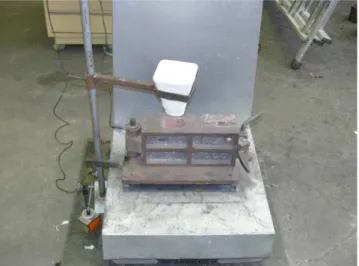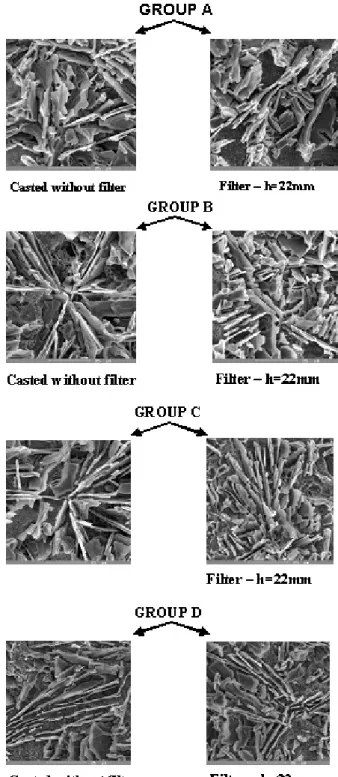A R C H I V E S
o f
F O U N D R Y E N G I N E E R I N G
Published quarterly as the organ of the Foundry Commission of the Polish Academy of Sciences
ISSN (1897-3310)
Volume 8
Issue 2/2008
13 – 16
3/2
A R C H I V E S o f F O U N D R Y E N G I N E E R I N G V o l u m e 8 , I s s u e 2 / 2 0 0 8 , 1 3 - 1 6 13
Filtration of aluminum alloys and its
influence on mechanical properties and
shape of eutectical silicium
M. Br
ů
na, D. Bolibruchová*, R. Kantorík
aFaculty of Mechanical Engineering, Department of Technology Engineering
University of Žilina, Univerzitná 1, 01026 Žilina
*Corresponding author. E-mail address: danka.bolibruchova@fstroj.uniza.sk
Received 03.032008; accepted in revised form 31.03.2008
Abstract
Filtration during casting of high quality aluminum alloys belongs to main refining methods. Even when there are many years of experiences and experimental works on this subject, there are still some specific anomalies. While using ceramic filtration media during casting of aluminum alloys, almost in all experiments occurred increase of strength limit and atypical increase of extension. This anomaly was not explained with classical metallurgical methods, black-white contrast after surface etching neither with color surface etching. For that reason was used deep etching on REM. By using pressed ceramic filters, by studying morphology eutectical silicon was observed modification morphology of eutectical silicon, this explains increase extension after filtration. Pressed ceramic filters were used on experimental works. Casting was executed on hardenable alloy AlSi10MgMn.
Keywords: Aluminum alloys, Eutectical silicon, Ductility, Pressed ceramic filter.
1. Introduction
Progressive materials with high-speed development in wide range of commercial applications are aluminum alloys Al – Si. Future of their further use is connected with their unique characteristic, resp. advantageous relation between mechanical properties and density. Largest use of these alloys is in the transport industry – automobile and aerial industry. Also often used in engineering industry and special role in army industry. Desirable mechanical properties may be considered one of the main reason for wide spectrum efficiency of aluminum alloys, therefore is very important to understand the factors, which have major impact on this properties. Main goal of this work was to execute group of experiments, to prove impact of filtration elements on morphology of eutectical silicon. Shape, deployment and scale of eutectical silicon are one of the factors, that have
direct impact on values of mechanical properties – in our case we focused on ductility. Also attention was given to changing shape and deployment of eutectical silicon, influenced by repeatedly re-melted batch material.
2. Experiments
Table 1.
Dividing of batch material
Group Dividing of samples for pouring Number of re-melting
3 samples – without filter
A
3 samples – filter h=22 mm – 3 samples – without filter
B
3 samples – filter h=22 mm 2x 3 samples – without filter
C
3 samples – filter h=22 mm 5x 3 samples – without filter
D
3 samples – filter h=22 mm 8x
Table 2.
Chemical structure of Al alloy AlSi10MgMn
Element Si Fe Cu Mn Mg Ni Pb Sn
[%] 11,28
0,1971 0,0026 0,2316 0,3313 <0,0016 0,0411 <0,0024
2.1 Technology of pouring
All experimental casts was executed in laboratory of casting in department of technology engineering – Žilina University. Melting of batch was executed in graphite melting-pot. Melting-pot with batch was inserted in electrical resistance furnace T15V, driven by PID regulator CAL 3200. Before melting, batch was preheated in electrical resistance furnace K 150 N. When the batch was melted and temperature stabilized on 730°C, casting to chill mould was executed as shown on Figure 1. Melt was not additional treated. 24 samples was poured by this way.
Fig. 1. System ready for casting
2.2. Evaluation of mechanical properties
To perform the test a load source (ZD 10/90, no. 46/79) has been used. The test was conducted in accordance with STN 42 0310. As a result of this test, the variable Rm ( tensile strength ) and A6 (elongation) have been obtained. The values (Rm, A6) are arithmetical averages of values obtained from 3 samples poured under identical conditions, to eliminate effect of random events and to ensure that the measurements was objective. From this values the graphs was created (figure 2 – 3), on which is represented relation of tensile strength and elongation from amount of re-melts and filter attendance.
Fig. 2. Relation of tensile strength on amount of re-melt and filter attendance
From most of graphs can be seen, that after the application of filtration media, the elongation is increasing as well as tensile strength. Examining with deep etching on REM is probably possible to explain this phenomenon.
In group D surprisingly occurred decrease of elongation in samples poured through the pressed ceramic filter in comparison with samples poured without the filtration media.
Fig. 3. Relation of elongation on amount of re-melt and filter attendance
This paradoxical effect can be probably explained by the influence of multiple re-melting. Every re-melt is material exposed to surrounding atmosphere, what results in a formation of more oxide films. The surface oxide films are entrained into the melt, what causes high porosity of test sample and so reduce effective section during a tensile impact test.
2.2. Interpretation results of deep etching on
REM
It was necessary prepare properly the sample to detail observation three-dimensional shape of eutectic silicon on REM. The sample submerged to etching solution (35 % HCl) with etched side down in time 1 min. Required relief created on sample after this time and it was possible document and interpret shape of eutectic silicon in each group (fig. 4) with REM. For purpose of work was chosen photograph, which represent character of structure etched surface.
Fig. 4. Observation of eutectic silicon with deep etching on REM
It is clear from figures, eutectic silicon has shape of platy, facetted, hexagonal formation.
By the formations are more extensive, larger, sharper thereby they have bigger impact effect and result decrease of elongation.
Representant samples chosen from group A have in both cases undirected distribution plates of eutectic silicon. By the compare
two samples from group A didn´t became to change of plates of eutectic silicon, in both cases is silicon in form of massive and cusped plates.
The sample from group B is casted without filter has frontage cusped distribution of plates, sample casted with filter has undirected distribution and the plates of silicon are visible softer. Same phenomenon occurred in group C and D what can be a proof of increasing elongation (fig. 2).
3. Conclusion
It was evidenced by the accomplished experiment, that using ceramic elements during casting has influence on the morphology of eutectic silicon and so on final elongation. In most cases come to improvement of elongation, what was evidenced by tensile impact test and with deep etching too. Only in one case come to decrease of elongation, what was probably caused by influence of multiple re-melting of batch material.
It was observed change of distribution plates of eutectic silicon by the influence of filtration and re-melting too.
Acknowledgements
This work originated by the solution of grant project KEGA č. 3/5197/07 a VEGA č. 1/3203/06, VEGA č. 1/4098/07, VEGA č. 1/0684/08.
References
[1] D. Bolibruchová, E. Tillová, Zlievarenské zliatiny Al-Si, 2005, s.97-101. ISBN 80-8070-485-6.
[2] A. Chojecki, St. M. Dobosz, Filtracja stopów przez filtry ceramiczne, transactions of the všb - technical university of ostrava, 2006, č.. 1, s. 87-92 ISSN 1210-0471.
[3] J. Campbell, Castings – second edition, 2003, s.30-33, ISBN 0-7506-4790-6.
[4] R. Pastirčák, A. Sládek, D. Bolibruchová, Simulácia filtrácie zlievarenských hliníkových zliatin, 2006, ISBN 80-8070-553-4.
[5] E. Tillová, M. Chalupová, aplikácia nekonvenčných metód hodnotenia štruktúry pri šstúdiu zliatin Al-Si-Mg. Slévárenství, LII, 2-3, 2004, s.75-79, ISSN 0037-6825.
[6] M. Barto, I. Vasková, Trendy využitia hliníkových zliatin v automobilovom priemysle. In: Acta Mechanica Slovaca, roč. 10, s.479-482, ISSN 1335-2393.

